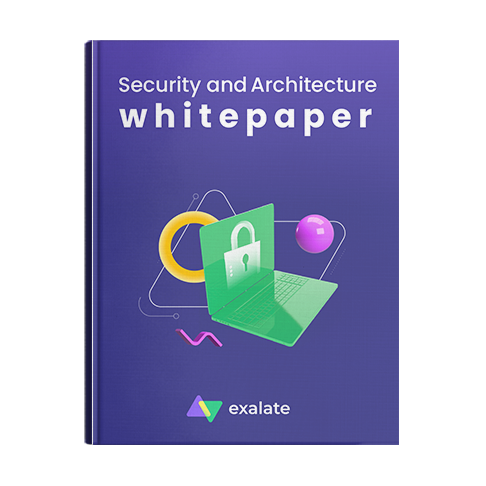How Netguru Uses Exalate to Significantly Reduce License Costs and Connect DevOps with their ITSM & Business Team
Client:

Integration:
Jira - JIRA


Cost reduction

Optimized processes

Maintained security and guaranteed autonomy

Increased harmony between different teams
From Design to Development, Netguru Helps you Face your Challenges
As a growing innovation consulting company with more than 650 people on board, Netguru builds digital products, from designing and developing fintech apps to building a multiplatform digital assistant for healthcare facilities.
They actually work with you to come up with a revolutionary digital product for your specific use case. So you can simply share your challenge with them, they will advise how to solve it and then will take care of it.
As a known company with mostly international clients around the world, their clients have changed the way people do banking, listen to music, learn languages, and rent bikes.
They started in 2008 as a Ruby on Rails company, to then support all sorts of modern technologies and offer a variety of services, from Angular to React, Python, and AI. They also provide design support, including both development and software design.
As a one-stop-shop, they also provide a variety of consulting, optimization, and marketing services. In March 2020 they became a Certified B Corporation, committed to change the world using technology and business as a force for good.
WHY EXALATE?
Reducing the monthly costs of marketing’s Service Desk by around 95%
Handling larger numbers of tickets
Flexible and easily configurable to meet every use case’s requirements
Smoother workflow

Take a look at what goes under the hood in regards to architecture, security and deployment options for Exalate
Paving the Way for a Smoother Collaboration
Netguru, with the ambition to become a global leader in digital transformation, has to constantly work on optimizing processes. They wanted their DevOps team, who operate on their own internal Jira Service Management, to be up-to-date on the work of other teams and in perfect sync with the commercial projects.
Plus, their Growth (marketing) team wanted to start using Jira as an issue-tracking and reporting solution. Naturally, they receive various requests on a daily basis from members of different teams, so it seemed to be a good idea to make use of Jira Service Management for the process of ticket creation.
But they faced some challenges:
- There was no easy way that a DevOps team, usually consisting of less than 10 people, could keep track of more than 100 active, commercial projects in the Jira environment and track if DevOps-related tickets are properly connected and synced with commercial projects and their teams.
- The size of the Growth team combined with Jira Service Management’s per-agent billing rule noticeably increased their monthly costs of Atlassian subscription.
So they decided to take action and smooth out the collaboration while optimizing the costs. And this is where Exalate came into the picture to integrate Jira Service Management and Jira Software.
Flexibility and Cost Optimization with Exalate
Netguru was experimenting with different tools and solutions to check if any of them met their specific use case’s requirements. That was especially the case with tools like Exalate that offered a free trial. This way, they could comfortably assess the solution, decide if they wanted to adopt it for the long term, and convince the board to make a purchase.
Piotr Radtke
Senior Project Manager at Netguru
There was a case where the marketing team wanted to use the Service Desk ticket creation process, but due to the size of the marketing team, the cost of running Service Desk agents for about 20-30 people was quite high with Jira.
As a solution, they managed to synchronize different types of projects with Exalate and they were able to save that money on agents because they now could use normal Jira accounts for marketing team members while maintaining the ability to use the Service Desk reporting solution.

In the DevOps case, Exalate is configured to connect commercial projects to their Jira Service Management. So whenever there’s a “DevOps synchronization” label, Exalate would pick it up as a trigger and create a synchronized reflection of that ticket on the Service Desk. Teams can then sync the flows using Exalate even if the workflows themselves are different. And afterward, the right people can take care of the tickets’ estimation, assignment, and execution.
There’s also the possibility to configure the fields that need to be synced, so the commercial projects and the DevOps teams are always collaborating smoothly and are kept up-to-date when it comes to their workflows and their tasks.
Piotr Radtke
Senior Project Manager at Netguru.
The DevOps team has benefited greatly from this. There has been an increase in the number of tickets the DevOps team is handling because they don't need to spend time on looking for appropriate commercial projects in the Jira environment to connect the executed work to. They have everything in one place thanks to Exalate that keeps everything in sync.

And what does stand out as the most prominent feature of the solution? We asked Piotr.
Piotr Radtke
Senior Project Manager at Netguru.
Netguru is also thinking about rolling out its Exalate network in the future in case there is a need to integrate their systems with external teams and other companies, as Exalate can easily support such use cases.

Results Recap
- Cost reduction
- Optimized processes
- Maintained security and guaranteed autonomy
- Increased harmony between different teams
As companies grow bigger and their collaboration becomes more extensive, the need to adopt a seamless integration is inevitable. With the right solution, they can save time, money, and resources and of course enjoy the ease of communication without having to handle everything manually. This will all lead to having stronger teams, smoother workflows, and more productivity.
Become an Exalate user and experience an optimized workflow and high productivity. It’s flexible enough for any sync use case.